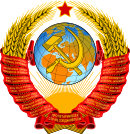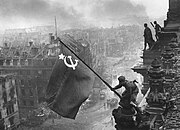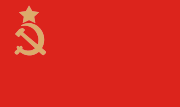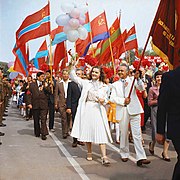Flag of the Soviet Union
 | |
| Красное Знамя(lit. 'Red Banner')[1] | |
| Use | State flag,civilandstate ensign |
|---|---|
| Proportion | 1:2 |
| Adopted | December 1922 (original) 19 August 1955 (last version) |
| Relinquished | 26 December 1991 |
| Design | Plainred banner,with the canton consisting of a goldhammer and sickletopped off by ared five-point starbordered in gold |
| Part ofa serieson the |
| Culture of the Soviet Union |
|---|
 |
| People |
| Languages |
| Traditions |
| Cuisine |
| Festivals |
| Literature |
| Music |
| Sport |
TheState Flag of the Union of Soviet Socialist Republics(Russian:Государственный флаг Союза Советских Социалистических Республик,romanized:Gosudarstvenny flag Soyuza Sovyetskikh Sotsialisticheskikh Respublik), or simply theSoviet flag(Russian:Советский флаг,romanized:Sovetsky flag), was ared bannerwith twocommunist symbolsdisplayed in thecanton:a goldhammer and sickletopped off by ared five-point starbordered in gold. The flag's design and symbolism are derived from several sources, but emerged during theRussian Revolution.It has also come to serve as the standard symbol representingcommunismas a whole, recognized as such in international circles, even after thedissolution of the Soviet Unionin 1991.
The plain red flag, which was a traditional revolutionary symbol long before 1917, was incorporated into the Soviet flag to pay tribute to the international aspect of theworkers' revolution.On the other hand, the unique hammer-and-sickle design was a modern industrial touch adopted from the Russian Revolution; it represented the "victorious and enduring revolutionary alliance" by unifying the hammer (i.e.,workers) and the sickle (i.e.,peasants). The gold-bordered five-point star situated above the hammer and sickle was a representation of theCommunist Party of the Soviet Union.
The first flag was adopted in December 1922. In 1923, 1924, 1936 and 1955, statutes were adopted that resulted in adjustments to the hammer's handle length and the sickle's shape. In 1980, an amendment was made to the 1955 decree that removed the hammer and sickle displayed on theflag's reverse side,though the legal description remained completely unchanged.[3]The design of the 1955 Soviet flag served as the basis for all of theflags of the Union Republics.
Symbolism and design
[edit]The flag of the Soviet Union consisted of a plainred flagwith a goldhammercrossed with a goldsickleplaced beneath a gold-borderedred star.This symbol is in the upper leftcantonof the red flag.
The colourredhonours thered flagof theParis Communeof 1871 and thered starandhammer and sicklearesymbols of communismandsocialism.
The hammer symbolises urbanindustrialworkers while the sickle symbolisesagriculturalworkers (peasants)—who together, as theProletarianclass, form the state. Thered starrepresents theCommunist Party,and its position over the hammer and sickle symbolises its leading role insocialist societyto unify and enlighten the workers and peasants in the building ofcommunism.
The flag's design was legislated in 1955, which gave a clear way to define and create the flag. This resulted in a change of the hammer's handle length and the shape of the sickle. The adopted statute stated that:[4]
- The ratio of width to length of the flag is 1:2.
- The hammer and sickle are in a square with sides equal to1⁄4of the flag's height. The sharp tip of the sickle lies in the center of the upper side of the square, and the handles of the hammer and sickle rest in the bottom corners of the square. The length of the hammer and its handle is3⁄4of the square diagonal.
- The five-pointed star is inscribed into a circle with a diameter of1⁄8of the flag's height, the circle being tangent to the upper side of the square.
- The distance of the vertical axis of the star, hammer and sickle from the hoist is1⁄3of the flag's height. The distance from the upper side of the flag to the center of the star is1⁄8of the flag's height.
Officially since 1980, the reverse side of the flag was a plain red field without the hammer and sickle. In practice, however, this was very commonly disregarded by flag makers as it was far easier and less costly to simply print the flagthrough and through,with the obverse design mirrored on the reverse.[5]It was also common to see the reverse of the flag bear the hammer and sickle in the obverse formation.[6]An example of the flag demonstrating itsde jurestatus as being only one-sided is that of the Soviet flag atop theMoscow Kremlinwhich bore the single-side official design.
For vertical display, the flag was made with the distinct difference of having the hammer and sickle rotated 90 degrees in order to compensate for the change in dimensions. Although common in official practice, a typical flag owner would simply turn a standard design flag 90 degrees to the right and hang it by thehoist(not flipped like the US flag).[7]
History
[edit]During the establishment of theRussian Soviet Republic,Vladimir Leninand his followers had considered the inclusion of a sword symbol in addition to the hammer and sickle as part of thestate sealon which the flag was eventually based. The idea was dismissed as too visually aggressive, with Lenin apparently affirming, "A sword is not one of our symbols."[8]
The first official flag was adopted in December 1922 at the First Congress of Soviets of the USSR. It was agreed that the red banner "was transformed from the symbol of the Party to the symbol of a state, and around that flag gathered the peoples of the soviet republics to unite into one state — the Union of Soviet Socialist Republics". On 30 December 1922, the Congress adopted a Declaration and Agreement on the establishment of the USSR. Article 22 of the Agreement states: "The USSR has a flag, coat of arms and a state seal." The description of the first flag was given in the1924 Soviet Constitution,accepted in the second session of the executive committee (CIK) of the USSR on 6 July 1923. The text of article 71 states: "The state flag of the Union of Soviet Socialist Republics consists of aredorscarletfield with the state'scoat of arms."It was ordered with the unusual ratio of 4:1 in proportion and consisted of ared flagwith the state coat of arms in the center. However, such a flag was never mass-produced. This flag was the official flag for four months, and was replaced as the official flag by the more familiarhammer and sickledesign during the third session of the CIK of the USSR on 12 November 1923.
In the third session of the CIK of the USSR, the description of Soviet flag in the Constitution was changed, and article 71 was edited to read: "The state flag of the Union of Soviet Socialist Republics consists of a red or scarlet field, and in the canton a golden sickle and hammer, and a red five-pointed star bordered in gold above them. The ratio of width to length is 1:2." On 19 August 1955, the Statute on the State Flag of the Union of Soviet Socialist Republics was adopted by a decision of thePresidium of the Supreme Soviet of the USSR.This resulted in a change of the hammer's handle length and the shape of the sickle. On 15 August 1980, a new edition of the Statute on the State Flag of the Union of Soviet Socialist Republics was adopted, which did not make any changes to the flag's description aside from removing the hammer and sickle on the reverse side of the flag.[9]From this point on, the flag stayed in use with this design until the disintegration of the USSR on 26 December 1991, at which time it ceased to be a national flag and replaced by national flags of thepost-Soviet republics.
On 15 April 1996Boris Yeltsinsigned a presidential decree giving the Soviet flag (called theVictory Banner,after the banner that was raised above theReichstagon 1 May 1945) status similar to that of the national flag. The hammer and sickle were removed from the flag, leaving only the star, but they were reinstated later. On certain holidays, the Victory Banner is flown along with the Russian flag.
Contemporary usage
[edit]In current times, the Soviet national flag (and similar flags) are widely used by those on thepolitical far left,most often by those who supportMarxism–Leninism,although the earlier (pre-Stalinist) flags are occasionally used byTrotskyistsand those on the moderncommunist left.
The Soviet flag is also actively promoted in Russia as a symbol ofnostalgia for the Soviet Union.Various politicians frequently utilize it as a symbol of the superpower status Russia lost in 1991.[10]
Amidst the backdrop of the2022 Russian invasion of Ukraine,theCommunist Party of the Russian Federationproposed to theState Dumathe adoption of the Soviet flag as the officialflag of Russiaon April 19, 2022.[11]The use ofSoviet symbols including its flag became very extensiveby invading Russian forces over the course of the war along with theletter "Z".[12]
On June 17, 2023, during the celebration for the 300th anniversary ofSaint Petersburg,the respective flags of the Russian Empire (Black-yellow-white flag), Soviet Union, andRussian Federationwere raised simultaneously at theGulf of Finland.[13][14][15][16]
- Historical evolution of the flag of the Soviet Union
-
(30 December 1922 – 12 November 1923)
-
(12 November 1923 – 18 April 1924)
-
(18 April 1924 – 5 December 1936)
-
(5 December 1936 – 19 August 1955)
-
(19 August 1955 – 26 December 1991)
Derived flags
[edit]Theflags of the Soviet republicsthat constituted theUSSRand theVictory Bannerwere alldefaced[note 1]or modified versions of the Soviet flag.
-
Ukrainian Soviet Socialist Republic(1937–50)
-
Ukrainian SSR
(1950–90) -
Flag of the Ukrainian SSR (1990)
-
Byelorussian SSR (1951–91) (served as an inspiration for theflag of Belarussince 1995)
-
Uzbek Soviet Socialist Republic(1952–91)
-
Kazakh Soviet Socialist Republic(1937–40)
-
Kazakh SSR (1940–53)
-
Kazakh SSR andKazakhstan(1953–92)
-
Georgian Soviet Socialist Republic(1951–90)
-
Azerbaijan Soviet Socialist Republic(1924–27)
-
Azerbaijan SSR
(1927–31) -
Azerbaijan SSR
(1931–37) -
Azerbaijan SSR
(1937–40) -
Azerbaijan SSR
(1940–52) -
Azerbaijan SSR
(1952–56) -
Azerbaijan SSR
(1956–91) -
Lithuanian Soviet Socialist Republic(1940–53)
-
Lithuanian SSR
(1953–88) -
Moldavian ASSR
(1937–38) -
Moldavian ASSR
(1938–40) -
Moldavian Soviet Socialist Republic
(1940–52) -
Moldavian SSR (1952–1990)
-
Pridnestrovian Moldavian Republic[note 2](1991–present)
-
Latvian Soviet Socialist Republic(1940–53)
-
Latvian SSR (1953–67)
-
Latvian SSR (1967–90)
-
Kirghiz Soviet Socialist RepublicandKyrgyzstan(1952–92)
-
Tajik Soviet Socialist Republic(1936–38)
-
Tajik SSR (1938–40)
-
Tajik SSR (1940–53)
-
Tajik SSR (1953–91)
-
Armenian Soviet Socialist Republic(1936–40)
-
Armenian SSR
(1940–52) -
Armenian SSR
(1952–90) -
Turkmen Soviet Socialist Republic(1926–37)
-
Turkmen SSR (1953–73)
-
Turkmen SSR andTurkmenistan(1973–92)
-
Estonian Soviet Socialist Republic(1940–53)
-
Estonian SSR (1953–90)
-
Karelo-Finnish SSR (1953–56)
-
Victory Bannerof theGreat Patriotic War(1945)
-
Flag of Vladimir Oblast(1999–2017)
-
Flag of Vladimir Oblast(2017–present)
Gallery
[edit]-
Digital remake of the flag that was raised over the Reichstag
-
The Soviet flag along with an assortment of Russian and Soviet military flags
-
Flags of the Soviet Republics flown during a parade inChișinău,the capital of theMoldavian SSR
-
Member of theArmed Forces of Belaruspays tribute to theVictory Dayin 2014, in front of a Soviet flag
See also
[edit]- Communist symbolism
- Flag of Russia
- Flags of the Soviet Republics
- Flags whose reverse differs from the obverse
- Hammer and sickle
- Red flag
- Red star
- State Emblem of the Soviet Union
Notes
[edit]- ^In vexillology, defacement is the addition of a symbol or charge to a flag.
- ^ThePridnestrovian Moldavian Republicor Transnistria, is an unrecognized breakaway republic formed in 1991 after the breakup of the Soviet Union from territory internationally recognized as part of Moldova after theTransnistria War.
- ^TheKarelo-Finnish SSRwas a short-lived Union Republic formed in 1940 from theKarelian ASSRwith territory ceded fromFinlandin theWinter War.In 1956, it was demoted back to an ASSR within theRSFSR.
References
[edit]- ^Whitney Smith (2008)."Flag of Flag of Union of Soviet Socialist Republics".Encyclopædia Britannica.Retrieved2008-11-05.
- ^Whitney., Smith (1980).Flags and arms across the world.Smith, Whitney. New York: McGraw-Hill. pp.203.ISBN9780070590946.OCLC4957064.
- ^"Положение о Государственном флаге Союза Советских Социалистических Республик | Геральдика.ру".geraldika.ru(in Russian).RetrievedMay 8,2022.
- ^USSR Supreme Soviet Presidium(19 August 1955).Положение о государственном флаге СССР(in Russian).Retrieved2008-11-05.
- ^"Construction details of Soviet flags".flagspot.net.Retrieved2017-11-18.
- ^"Reverse of the flag - Soviet Union".flagspot.net.Retrieved2017-11-18.
- ^"Vertical hoisting – Soviet Union".flagspot.net.Retrieved2017-12-05.
- ^Konstantin AndreevichIvanov (1971).Flags of the states of the world(in Russian). Moscow: Izd-vo Transport. p.[page needed].OCLC20146023.
- ^Russian Centre of Vexillology and Heraldry."Флаги СССР".vexillographia.ru.Archived fromthe originalon 21 February 2014.Retrieved11 January2019.
- ^Hoffman, David (2000-12-05)."Putin Seeks Restoration Of Soviet Symbols".The Washington Post.ISSN0190-8286.Retrieved2021-08-22.
- ^"КПРФ внесла в Госдуму законопроект, предлагающий установить флаг СССР флагом России".kprf.ru(in Russian).Retrieved2022-04-19.
- ^Young, Pareisa (11 March 2022)."Ukraine: Russian troops flying Soviet flag, symbol of 're-establishing Russian domination'".The Observers -France 24.Archivedfrom the original on 27 April 2022.Retrieved4 May2022.
- ^"В Петербурге на высоту 179 метров торжественно подняли флаги трёх исторических эпох".Rossiyskaya Gazeta(in Russian). 2023-06-17.Retrieved2023-06-20.
- ^"Путин принял участие в церемонии поднятия флагов РФ, СССР и Российской империи в Петербурге".Rossiyskaya Gazeta(in Russian). 2023-06-17.Retrieved2023-06-20.
- ^"Путин с катера наблюдал за поднятием в Петербурге флагов РФ, СССР и Российской империи".TASS(in Russian).Retrieved2023-06-20.
- ^"В Санкт-Петербурге торжественно подняли флаги трёх исторических эпох".Moskovskij Komsomolets(in Russian). 2023-06-17.Retrieved2023-06-20.
External links
[edit] Media related toFlags of the Soviet Unionat Wikimedia Commons
Media related toFlags of the Soviet Unionat Wikimedia Commons- Soviet UnionatFlags of the World


































![Pridnestrovian Moldavian Republic[note 2] (1991–present)](https://upload.wikimedia.org/wikipedia/commons/thumb/b/bc/Flag_of_Transnistria_%28state%29.svg/120px-Flag_of_Transnistria_%28state%29.svg.png)
















![Karelo-Finnish Soviet Socialist Republic[note 3] (1940–53)](https://upload.wikimedia.org/wikipedia/commons/thumb/2/2d/Flag_of_the_Karelo-Finnish_Soviet_Socialist_Republic_%281940%E2%80%931953%29.svg/120px-Flag_of_the_Karelo-Finnish_Soviet_Socialist_Republic_%281940%E2%80%931953%29.svg.png)











